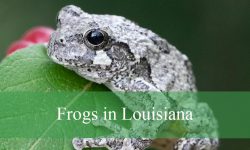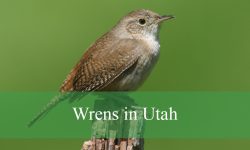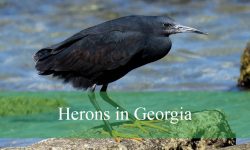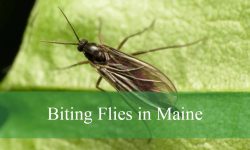Arkansas is a haven for birdwatchers, offering a rich mix of habitats from forests and wetlands to suburban backyards. Walking through the state’s trails or even exploring a local park, you can encounter a surprising variety of birds, each with unique colors, calls, and behaviors that make spotting them an exciting experience.
For both beginners and seasoned birders, knowing what to look for can transform a simple walk into a rewarding adventure. From the vibrant Northern Cardinal perched on a feeder to the soaring Red-tailed Hawk overhead, Arkansas’ birds offer endless opportunities for observation and photography.
This guide highlights 45 common birds you’re likely to encounter in Arkansas. Each entry includes identification tips, pictures, and interesting facts to help you recognize and appreciate the state’s avian residents on your next outing.
Most Common Birds Found in Arkansas
Tufted Titmouse (Baeolophus bicolor)
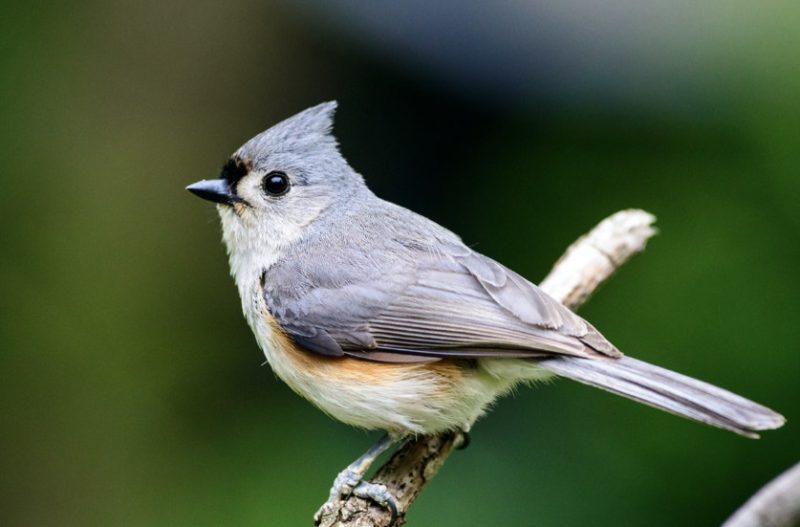
The Tufted Titmouse is a small, lively songbird with soft gray upperparts, a white belly, and a subtle rust-colored patch under the wings. Its most distinctive feature is the pointed crest on its head, paired with large, dark eyes and a short, sturdy bill. Both males and females share the same attractive appearance.
In Arkansas, Tufted Titmice are common in deciduous forests, wooded suburbs, and parks. They often join mixed-species flocks with chickadees, nuthatches, and woodpeckers, especially during winter. Their clear, whistled “peter-peter-peter” song is a familiar sound in the state’s woodlands.
A fun fact about Tufted Titmice is that they sometimes pluck hair from living animals, including squirrels and even humans, to use as nesting material. This quirky behavior has earned them the nickname “hair thieves” among bird enthusiasts.
Northern Cardinal (Cardinalis cardinalis)
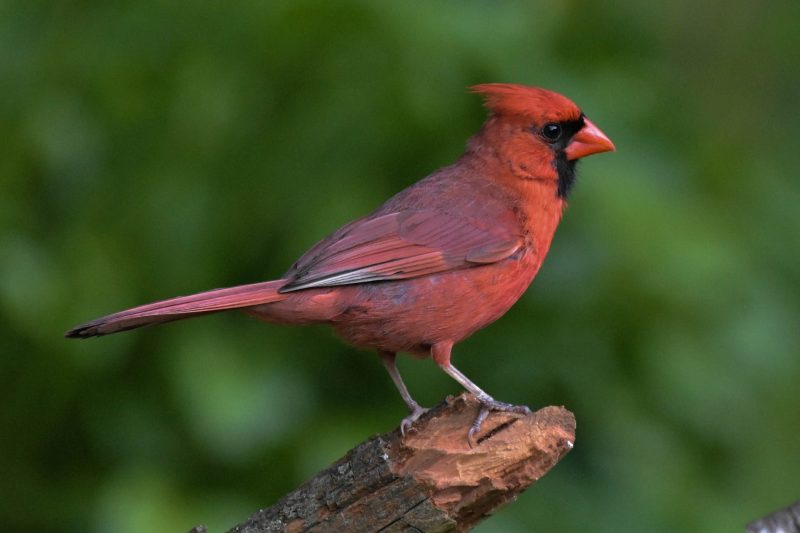
The Northern Cardinal is one of Arkansas’s most recognizable birds, thanks to its vibrant plumage and melodic songs. Males display bright crimson feathers with a black mask around the face, while females are a warm brown with hints of red on the crest, wings, and tail. Both sexes have a distinctive crest and a stout, cone-shaped orange beak that makes them easy to identify year-round.
In Arkansas, Northern Cardinals can be found in woodlands, suburban gardens, and parks. They are non-migratory, meaning they remain in the state through all seasons, adding color to winter landscapes. Cardinals are known for their rich, whistling songs, often sung by both males and females, which is uncommon among North American songbirds.
A fun fact about the Northern Cardinal is that they are so beloved in the United States that they are the official state bird of seven states. They also have an interesting habit of attacking their reflection in windows or mirrors, mistaking it for a rival bird intruding on their territory.
American Robin (Turdus migratorius)
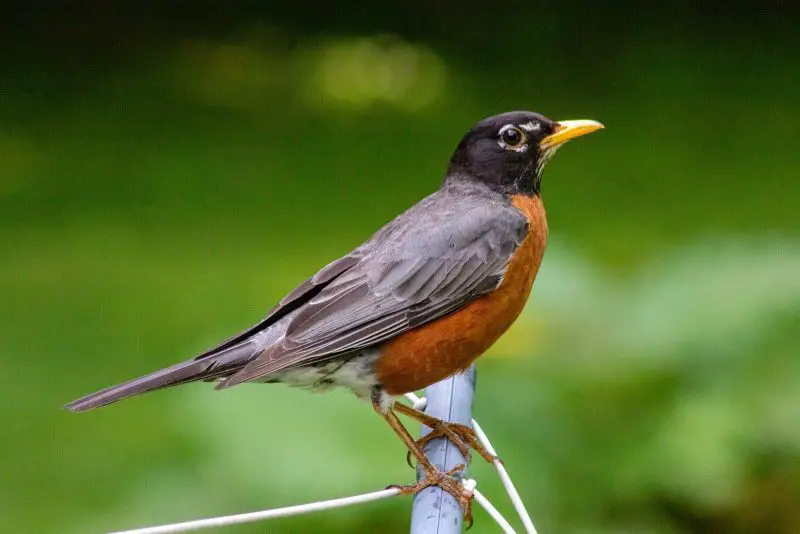
The American Robin is a familiar sight in Arkansas, recognized for its warm orange breast, grayish-brown back, and white eye ring. These medium-sized thrushes have a long tail and a yellow bill, making them easy to spot as they hop across lawns in search of food. Males tend to have richer, darker coloration compared to females.
Robins are found across the state in open woodlands, gardens, and grassy areas. They are well known for their feeding behavior—listening for earthworms in the soil and quickly pulling them out with a sharp tug. In Arkansas, they are year-round residents, though some may migrate further south in colder months.
A fun fact about American Robins is that their arrival in large numbers often signals the coming of spring. However, in Arkansas, they can be seen even in winter, especially in flocks feeding on berries from trees and shrubs.
Blue Jay (Cyanocitta cristata)
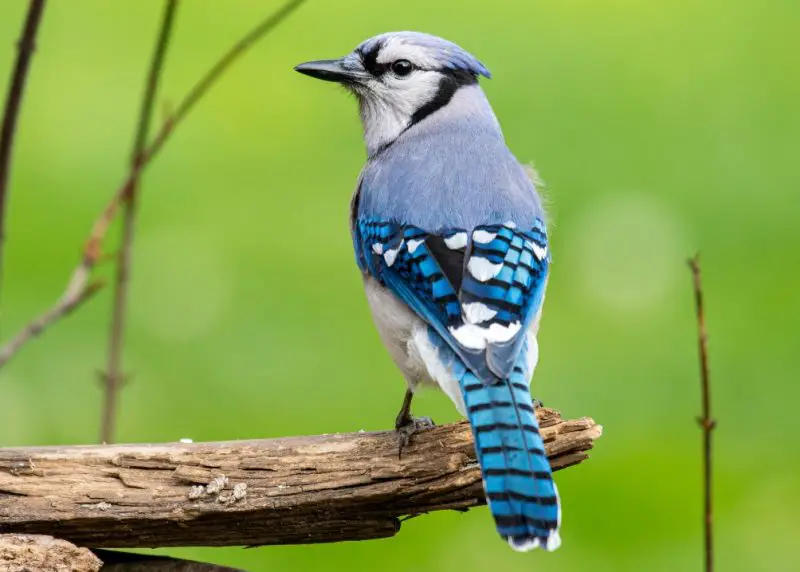
The Blue Jay is a striking and intelligent bird found throughout Arkansas, sporting bright blue upperparts, a white face, and a black necklace-like band across the throat. Its wings and tail are patterned with black and white, creating a bold, beautiful contrast. Males and females look alike, and both are known for their loud, varied calls.
Blue Jays inhabit forests, suburban neighborhoods, and parks, often staying near oak trees, as acorns are a favorite food. They are also omnivorous, eating seeds, nuts, insects, and occasionally small vertebrates. Their behavior is curious and bold, and they are known to mimic the calls of hawks to deceive other birds.
A fun fact about Blue Jays is their remarkable memory—they can remember where they store hundreds of acorns, helping them survive through winter. Interestingly, they play an important ecological role in spreading oak trees by forgetting some of their buried seeds.
Eastern Bluebird (Sialia sialis)
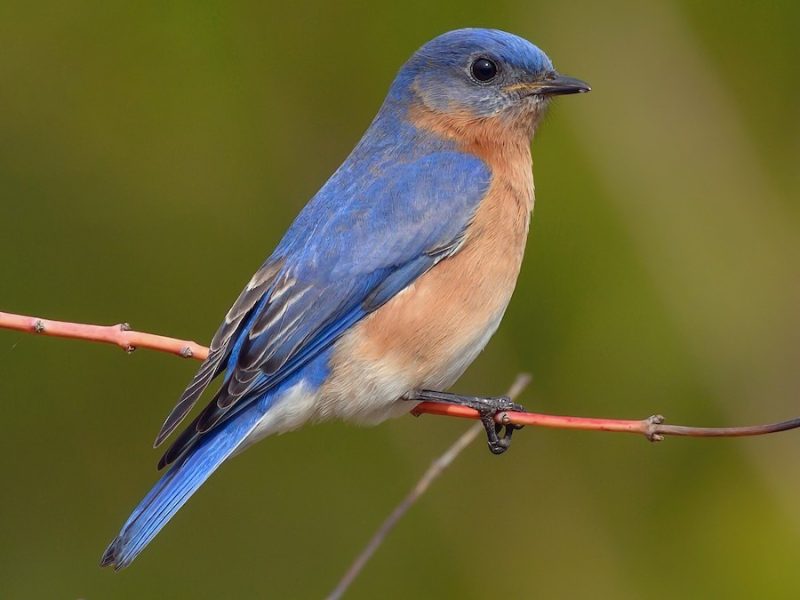
The Eastern Bluebird is a small, charming bird with a bright blue back and wings, a rusty orange chest, and a white belly. Females are slightly duller in color but still carry the same gentle pattern. Their soft, warbling calls and vivid plumage make them a favorite sight for birdwatchers in Arkansas.
Eastern Bluebirds prefer open fields, meadows, and woodland edges with scattered trees. In Arkansas, they often nest in tree cavities or birdhouses provided by people. They are insect-eaters in the warmer months and switch to berries during winter when insects are scarce.
A fun fact about Eastern Bluebirds is that they are a symbol of happiness and renewal. Their populations in Arkansas benefited greatly from birdhouse conservation programs, which helped them recover after declines caused by competition with invasive species like House Sparrows and European Starlings.
Carolina Chickadee (Poecile carolinensis)
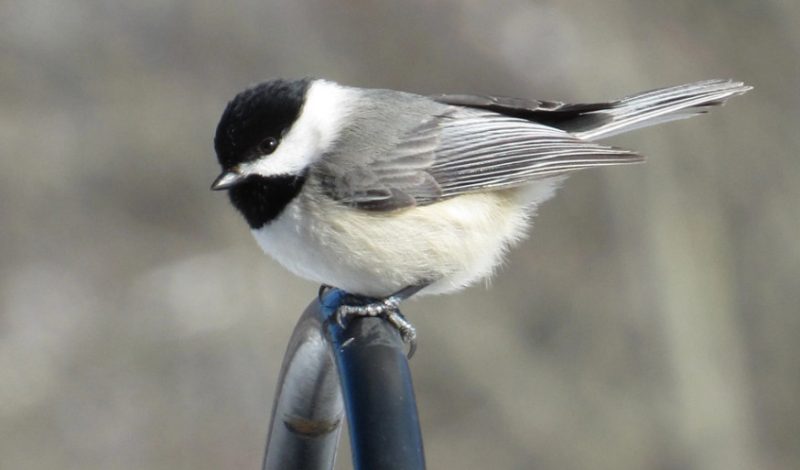
The Carolina Chickadee is a small, active songbird with a distinctive black cap and bib, white cheeks, and soft gray wings and back. Its short neck and round body give it a cute, almost fluffy appearance. Males and females look identical, and their familiar “chick-a-dee-dee-dee” call is easy to recognize.
In Arkansas, Carolina Chickadees thrive in deciduous and mixed forests, as well as in suburban yards with bird feeders. They are agile foragers, often hanging upside down on branches while searching for insects, seeds, and berries. These birds are non-migratory, staying in the state throughout the year.
A fun fact about the Carolina Chickadee is that they have excellent spatial memory, allowing them to hide food in bark crevices and remember the locations for later. They also increase the number of “dee” notes in their call to warn of higher levels of danger.
Red-bellied Woodpecker (Melanerpes carolinus)
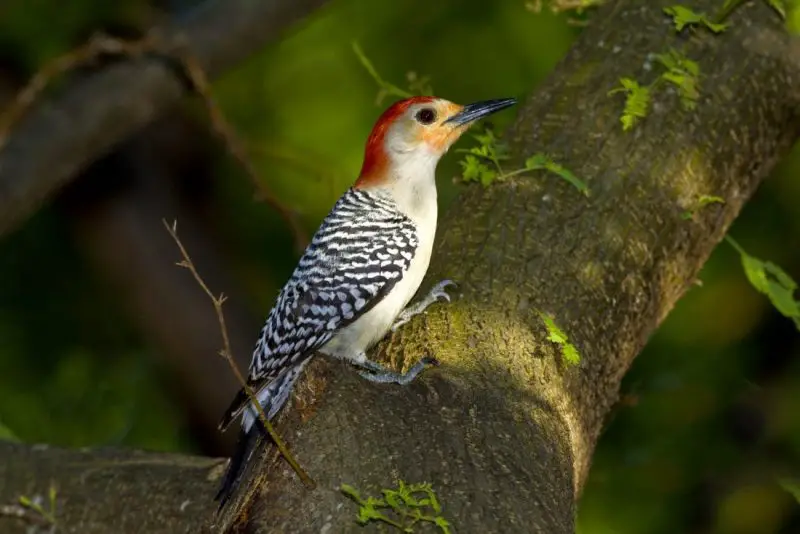
The Red-bellied Woodpecker is a medium-sized bird with striking black-and-white barred wings and back. Its head features a vivid red cap and nape in males, while females have red only on the nape. Despite its name, the pale reddish wash on its belly is often faint and hard to see.
This woodpecker is common in Arkansas woodlands, forests, and suburban areas with mature trees. It uses its strong bill to drill into bark for insects and also eats nuts, fruits, and seeds. Its rolling “churr” call is a frequent sound in the state’s wooded habitats.
A fun fact about the Red-bellied Woodpecker is that it has a long, sticky tongue that can extend up to two inches past its beak—perfect for extracting insects from deep crevices. It also stores food in tree bark for later use, especially in colder months.
Downy Woodpecker (Dryobates pubescens)
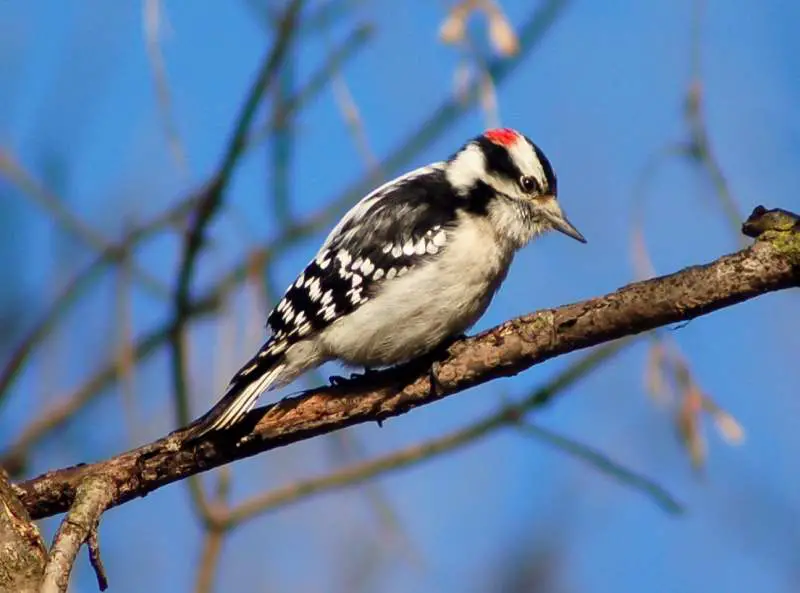
The Downy Woodpecker is the smallest woodpecker in Arkansas, measuring just about 6 inches in length. It has a black-and-white checkered pattern, a white belly, and a short bill. Males have a small red patch on the back of the head, while females do not.
Downy Woodpeckers are adaptable and found in forests, orchards, and backyards with bird feeders. They often accompany chickadees and nuthatches in foraging flocks, skillfully tapping at tree bark to find insects. They also eat seeds and suet, making them regular visitors to feeders.
A fun fact about Downy Woodpeckers is that their drumming sounds are used not for feeding but for communication—especially to establish territory and attract mates. They can drum up to 15 beats per second on resonant tree trunks or metal objects.
Pileated Woodpecker (Dryocopus pileatus)
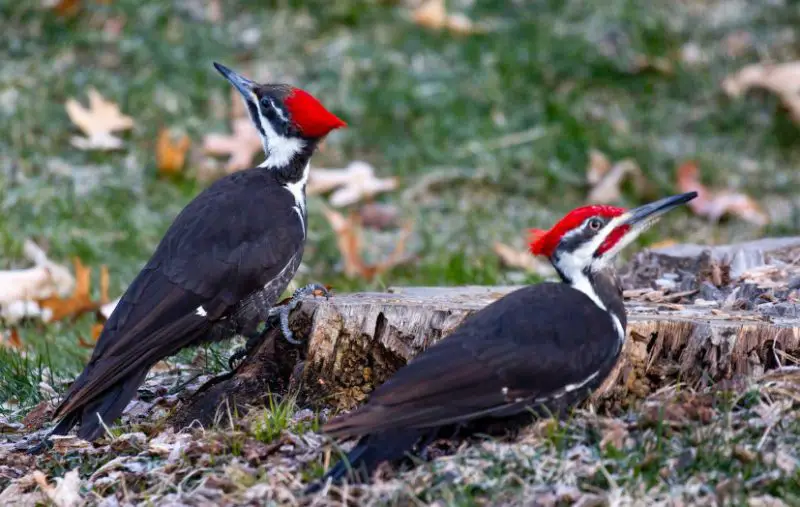
The Pileated Woodpecker is the largest woodpecker in Arkansas, almost crow-sized, with bold black-and-white plumage and a striking red crest. Males have a red stripe along the cheek, while females do not. Its strong bill creates large rectangular holes in trees when searching for carpenter ants.
These woodpeckers prefer mature forests, but in Arkansas, they can also be found in wooded suburbs with plenty of tall trees. Their loud, ringing “cuk-cuk-cuk” calls and powerful drumming can be heard from a distance. They are known for their acrobatic foraging, often clinging to tree trunks and even hopping around fallen logs.
A fun fact about Pileated Woodpeckers is that their deep excavations create nesting cavities later used by owls, ducks, and other birds, making them important “ecosystem engineers” in Arkansas forests.
American Goldfinch (Spinus tristis)

The American Goldfinch is a small, bright songbird that changes its appearance with the seasons. Males in breeding plumage are a vibrant yellow with black wings and a black cap, while females are a softer yellow-brown. In winter, both sexes take on a muted olive-brown tone.
Goldfinches in Arkansas are found in open fields, weedy areas, gardens, and at bird feeders stocked with sunflower or nyjer seeds. They are agile, acrobatic feeders, often seen hanging upside down to extract seeds from plants. Their flight is bouncy and undulating, accompanied by a cheerful “per-chick-o-ree” call.
A fun fact about the American Goldfinch is that it is one of the latest-nesting songbirds in North America, often starting in mid-summer when thistle plants produce seeds—their primary food source for feeding young.
House Finch (Haemorhous mexicanus)
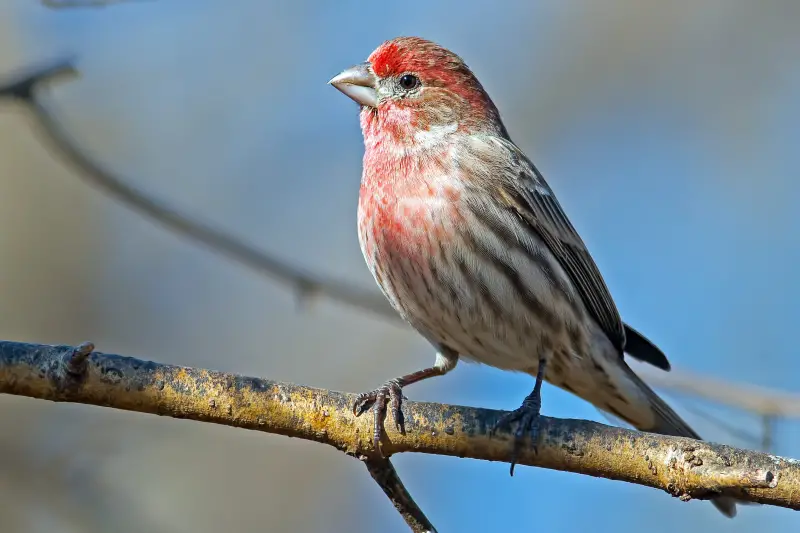
The House Finch is a small, sociable bird with a conical bill and a long, slightly notched tail. Males are easily recognized by their rosy-red heads, throats, and chests, while females are brown and streaky overall. Both sexes share a lively, musical song that is common in Arkansas neighborhoods.
In Arkansas, House Finches thrive in suburban areas, city parks, and rural communities, often gathering in flocks at bird feeders. They eat seeds, buds, and fruits, and their adaptable nature makes them successful in a variety of environments. Their cheerful, warbling songs can be heard year-round.
A fun fact about the House Finch is that the shade of red in males comes from pigments in their diet—more carotenoid-rich foods lead to brighter coloring, which can influence their attractiveness to females during mating season.
Purple Finch (Haemorhous purpureus)
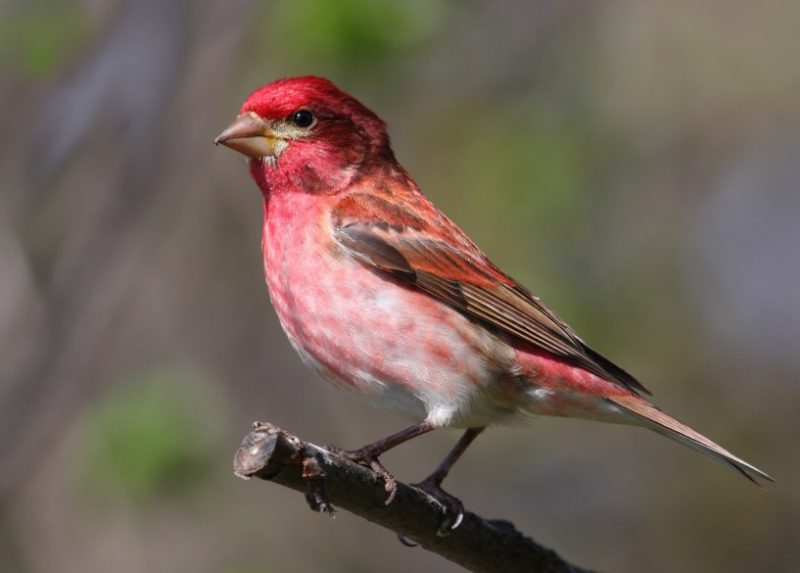
The Purple Finch is a chunky, sparrow-like bird with a short, conical bill. Males are a rich raspberry-red on the head, breast, and back, blending into brown wings, while females are heavily streaked in brown and white with a distinct whitish eyebrow stripe.
In Arkansas, Purple Finches are typically winter visitors, arriving from northern breeding grounds to feed on seeds and berries. They often visit backyard feeders, especially those offering sunflower seeds, and can be found in mixed flocks with other finches and sparrows.
A fun fact about the Purple Finch is that poet Robert Frost once called it “a bird that’s dipped in raspberry juice,” a nod to the male’s vivid coloration. Despite its name, the bird is more red than purple.
White-breasted Nuthatch (Sitta carolinensis)

The White-breasted Nuthatch is a small, agile bird with a white face and underparts, a black or gray crown, and blue-gray upperparts. Its strong bill and short tail make it well-suited for its unique foraging style—climbing headfirst down tree trunks in search of insects and seeds.
In Arkansas, these nuthatches live in mature woodlands, parks, and backyards with large trees. They are frequent feeder visitors, often grabbing a seed and flying away to cache it for later. Their nasal “yank-yank” call is a familiar sound in wooded areas.
A fun fact about the White-breasted Nuthatch is that it smears insects or resin around the entrance to its nest cavity, possibly to deter predators like squirrels or other birds from intruding.
Brown-headed Nuthatch (Sitta pusilla)
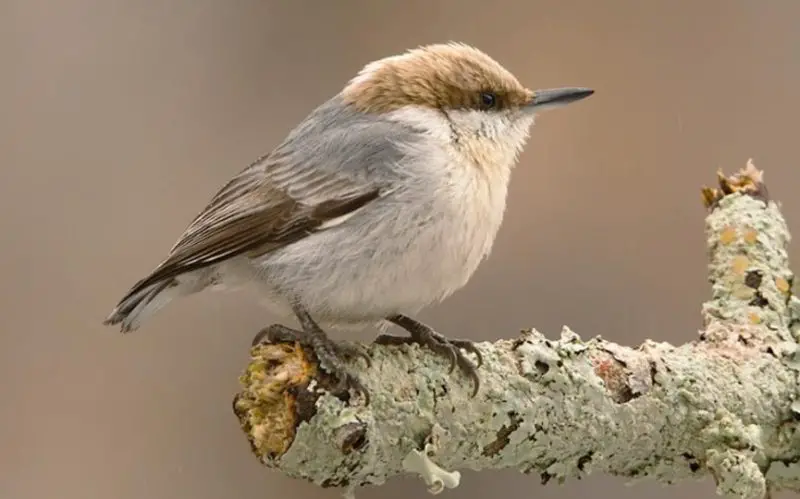
The Brown-headed Nuthatch is a tiny, energetic bird with a warm brown cap, blue-gray back, and white underparts. Its high-pitched, squeaky “rubber duck” call is distinctive and often heard before the bird is seen.
This species is found mainly in pine forests, and in Arkansas, it is associated with the state’s pine woodlands and mixed pine-oak habitats. Brown-headed Nuthatches are skilled climbers, often foraging along branches and tree trunks for insects and seeds.
A fun fact about the Brown-headed Nuthatch is that it is one of the few North American bird species known to use tools. They have been observed using small pieces of bark to pry insects out of crevices in tree bark.
Carolina Wren (Thryothorus ludovicianus)
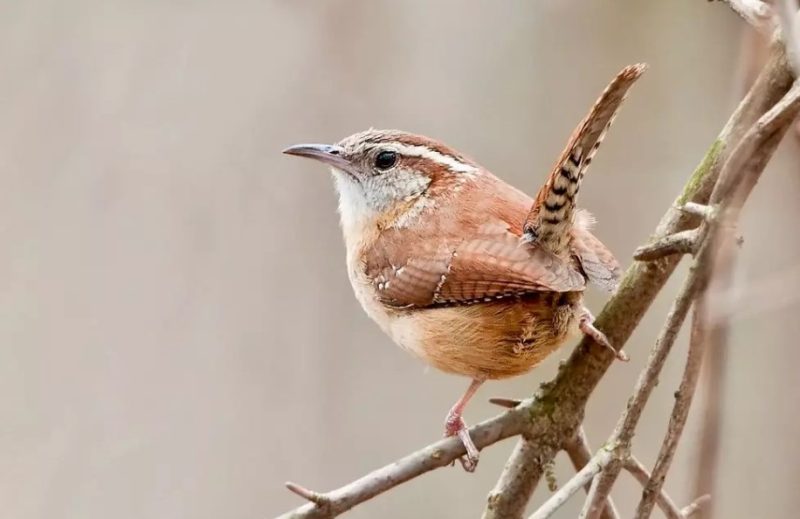
The Carolina Wren is a small, round-bodied bird with a rich reddish-brown back, buff underparts, and a long, slightly curved bill. Its bold white eyebrow stripe and cocked tail make it easy to identify. Males and females look alike and are both energetic and vocal.
In Arkansas, Carolina Wrens inhabit forests, thickets, gardens, and suburban yards. They are curious and often explore porches, garages, and sheds in search of insects and nesting spots. Their loud, ringing “tea-kettle, tea-kettle, tea-kettle” song can be heard year-round.
A fun fact about the Carolina Wren is that pairs stay together for life and maintain their territory through all seasons, often singing duets to strengthen their bond and ward off intruders.
House Wren (Troglodytes aedon)
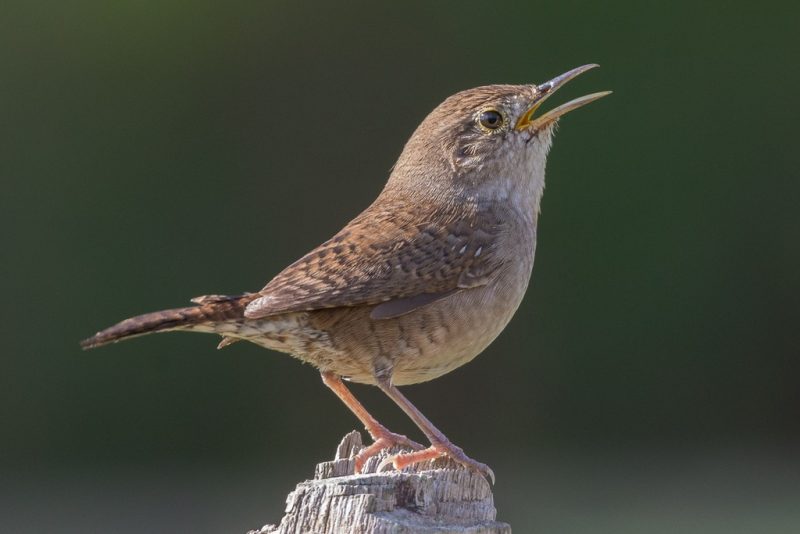
The House Wren is a small, active bird with plain brown plumage and fine barring on the wings and tail. Its slightly curved bill and constantly flicking tail make it easy to recognize despite its subtle coloring. Males and females look alike, and both are known for their lively, bubbly songs.
In Arkansas, House Wrens are most common in spring and summer, inhabiting open woodlands, gardens, and backyards. They readily use nest boxes and other cavities, often building their nests in unusual places like flowerpots, old cans, or boots left outside. They feed on insects, spiders, and other small invertebrates.
A fun fact about the House Wren is that males sometimes build multiple “dummy nests” to attract a mate and discourage rivals from settling nearby. These birds are fierce defenders of their territory, often removing nesting material from other birds’ cavities.
Eastern Towhee (Pipilo erythrophthalmus)
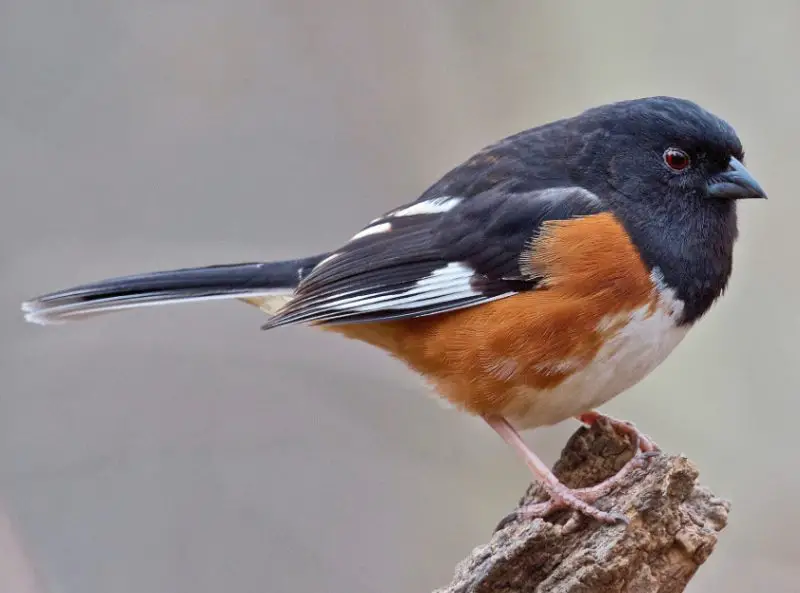
The Eastern Towhee is a striking, large sparrow with bold black upperparts in males, rusty-red sides, and a white belly. Females have the same pattern but with warm brown replacing the black. Their bright red eyes stand out against their plumage, especially in good light.
In Arkansas, Eastern Towhees prefer brushy edges, thickets, and overgrown fields. They spend much of their time on the ground, scratching in leaf litter for insects, seeds, and fruits. Their sharp “chewink” call and sweet “drink-your-tea” song are distinctive in the state’s woodlands.
A fun fact about the Eastern Towhee is that it uses a two-footed, backward-scratching motion to uncover food—a unique foraging technique that leaves small patches of cleared ground in the leaf litter.
Dark-eyed Junco (Junco hyemalis)
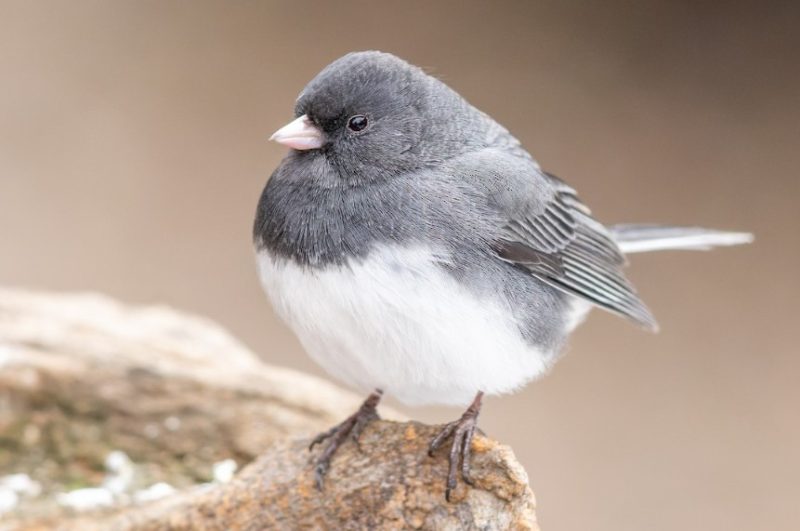
The Dark-eyed Junco is a small, round-bodied sparrow with slate-gray plumage above and a white belly. Its pink bill and flashing white outer tail feathers are key identification features. In Arkansas, the most common form is the “slate-colored” variety, though other regional variations may appear in winter.
These birds are winter visitors to Arkansas, arriving from northern breeding grounds. They frequent open woodlands, fields, and backyards, often foraging on the ground for seeds. Their presence at feeders in late fall is a sign of the changing seasons.
A fun fact about Dark-eyed Juncos is that they are sometimes called “snowbirds” because their arrival often coincides with the first snowfall in many parts of their range, even though Arkansas winters are relatively mild.
White-throated Sparrow (Zonotrichia albicollis)
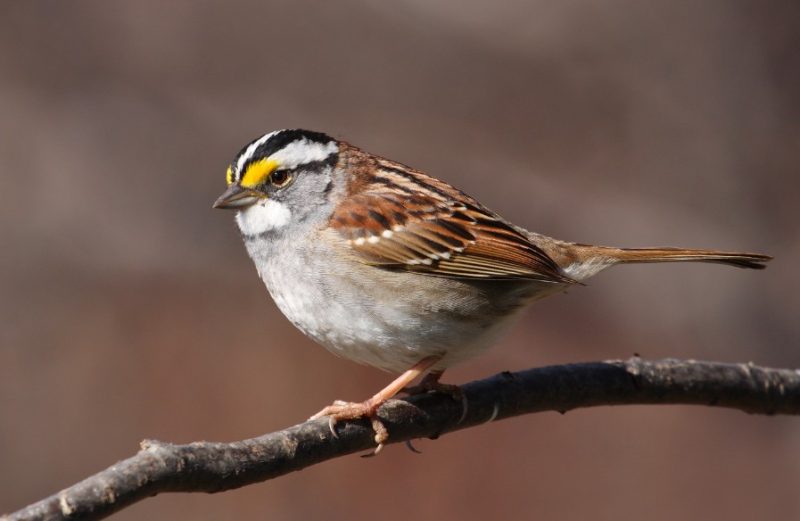
The White-throated Sparrow is a medium-sized sparrow with a bright white throat patch, yellow spots between the eyes and bill, and a bold head pattern of black and white or black and tan stripes. Both color variations can be seen in Arkansas during the cooler months.
In Arkansas, they are common winter visitors, foraging in leaf litter for seeds and insects. They prefer woodland edges, brushy areas, and backyards with dense cover. Their clear, whistled song, often described as “Oh-sweet-Canada-Canada,” is a delightful sound during migration and winter.
A fun fact about the White-throated Sparrow is that the two color forms (white-striped and tan-striped) are linked to their mating behavior—most birds pair with a mate of the opposite color morph, maintaining genetic diversity in the population.
Song Sparrow (Melospiza melodia)
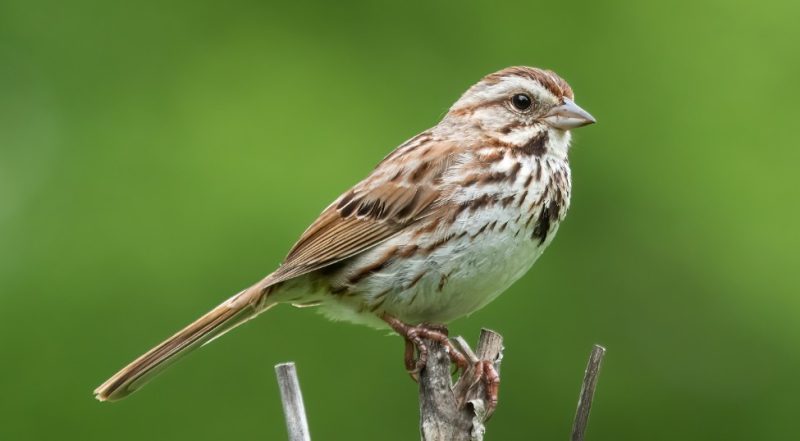
The Song Sparrow is a medium-sized, streaky brown bird with a warm brown back, heavily streaked underparts, and a distinctive central breast spot. Its long tail is often pumped as it moves, and its face pattern features gray and brown tones.
In Arkansas, Song Sparrows are found near water, in brushy fields, and in gardens with dense vegetation. They feed on seeds and insects, often scratching at the ground or probing the soil for food. Their song is a rich series of notes and trills, easily heard in spring and summer.
A fun fact about the Song Sparrow is that it has one of the most variable songs of any North American bird, with regional “dialects” across its range. Males can learn and sing multiple versions, which may help them stand out to females.
Chipping Sparrow (Spizella passerina)
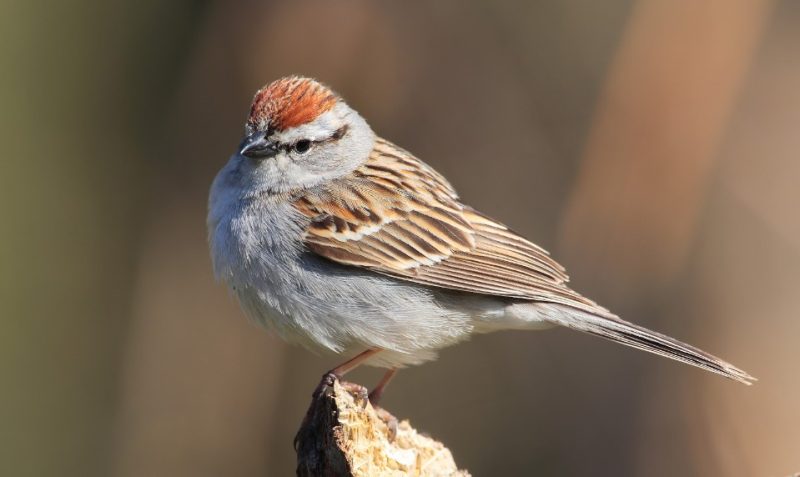
The Chipping Sparrow is a small, slender sparrow with a clean gray breast, a rusty-red crown, and a distinct black eye line. Its neat, crisp appearance makes it easy to distinguish from other sparrows, especially in spring and summer. During winter, the crown becomes duller and the face pattern less bold.
In Arkansas, Chipping Sparrows are common in open woodlands, parks, and suburban areas, especially where scattered trees meet grassy spaces. They feed on seeds and insects, often foraging on the ground or low vegetation. Their song is a dry, steady trill, repeated for long periods during the breeding season.
A fun fact about the Chipping Sparrow is that it readily adapts to human presence, often nesting in ornamental shrubs or small trees in backyards. They have also been known to reuse old nests from other birds, adding their own touches.
Eastern Meadowlark (Sturnella magna)

The Eastern Meadowlark is a chunky, robin-sized bird with a bright yellow breast marked by a bold black “V” and mottled brown upperparts. Its short tail flashes white in flight, and its sharp, spear-like bill is perfect for probing the ground for food.
In Arkansas, Eastern Meadowlarks are found in open grasslands, hayfields, and pastures. They feed on insects in summer and switch to seeds and grains in winter. Their flutelike, whistled song is a welcome sound in rural areas during spring and summer.
A fun fact about the Eastern Meadowlark is that it’s not actually a lark but a member of the blackbird family. Despite its beautiful voice, its population has been declining in many areas due to habitat loss from agricultural changes.
Red-winged Blackbird (Agelaius phoeniceus)
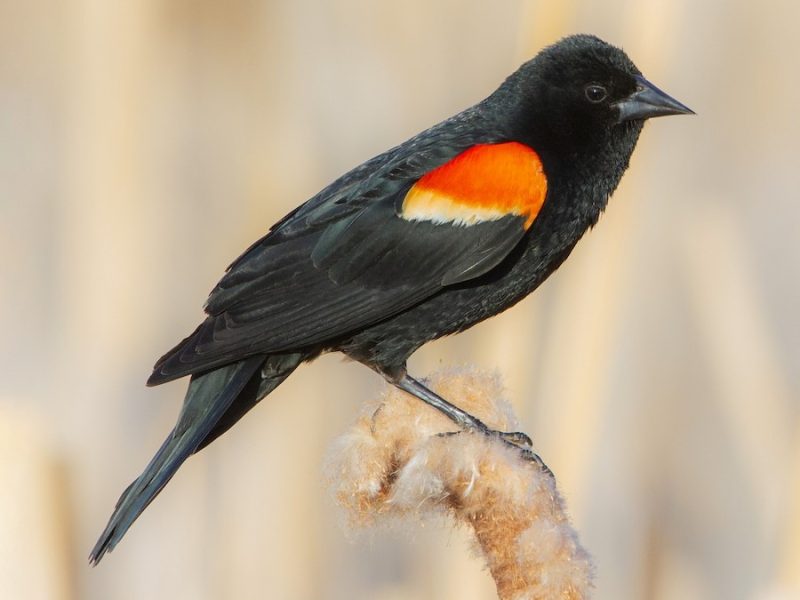
The Red-winged Blackbird is a medium-sized bird with glossy black plumage in males, accented by bright red shoulder patches edged in yellow. Females are brown and streaky, resembling large sparrows, which helps them blend into nesting areas.
In Arkansas, they are abundant in wetlands, marshes, and grassy fields. Males perch prominently and sing a distinctive “conk-la-ree” song to defend their territories. They feed on insects in the breeding season and switch to seeds and grains in winter, often forming large flocks.
A fun fact about the Red-winged Blackbird is that males may mate with multiple females in their territories, sometimes overseeing up to 15 different nests during a single breeding season.
Common Grackle (Quiscalus quiscula)
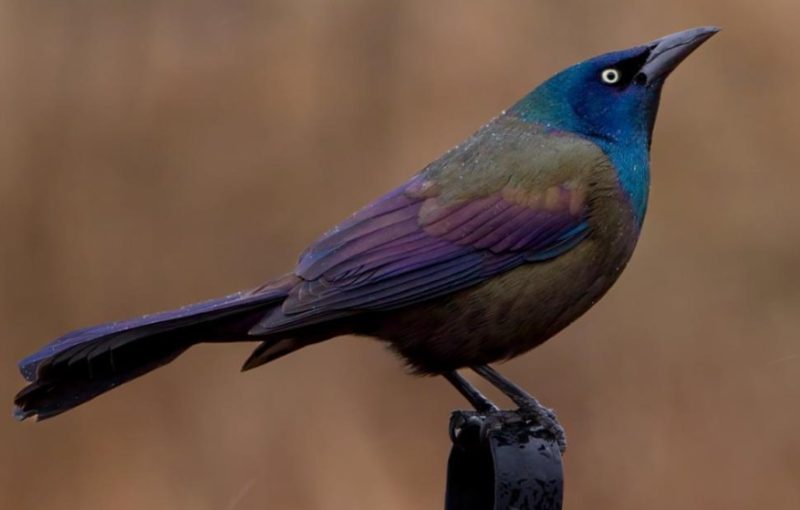
The Common Grackle is a large, lanky blackbird with glossy, iridescent plumage that can shine purple, green, or bronze in sunlight. It has a long, keel-shaped tail and pale yellow eyes that give it a striking, almost intense look.
In Arkansas, Common Grackles are found in fields, woodlands, and urban areas, often in large, noisy flocks. They are opportunistic feeders, eating insects, seeds, fruits, and even small animals. Their calls are harsh and metallic, often heard before the bird is spotted.
A fun fact about the Common Grackle is that it has been observed dunking hard food items, like dry bread or dog kibble, in water to soften them before eating—showing a surprising level of problem-solving ability.
Brown-headed Cowbird (Molothrus ater)
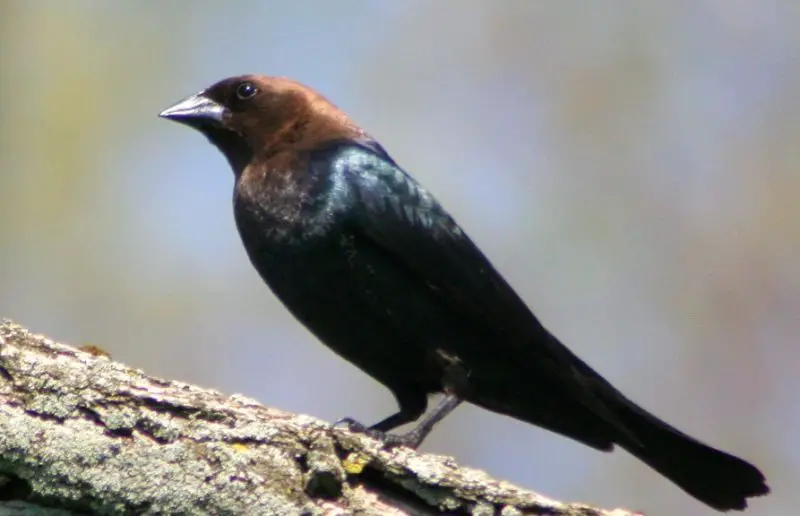
The Brown-headed Cowbird is a small blackbird with males sporting glossy black plumage and a rich brown head, while females are plain brown overall. Both have short, thick bills suited for cracking seeds.
In Arkansas, they are often found in open fields, agricultural areas, and at forest edges. Brown-headed Cowbirds are notorious for their brood parasitism—females lay their eggs in the nests of other bird species, leaving them to raise the cowbird chicks. They feed on seeds and insects, often foraging on the ground in mixed flocks.
A fun fact about the Brown-headed Cowbird is that it may lay eggs in the nests of more than 40 different bird species in a single breeding season, sometimes leading to the decline of smaller songbirds that are unable to compete with the fast-growing cowbird chicks.
American Crow (Corvus brachyrhynchos)
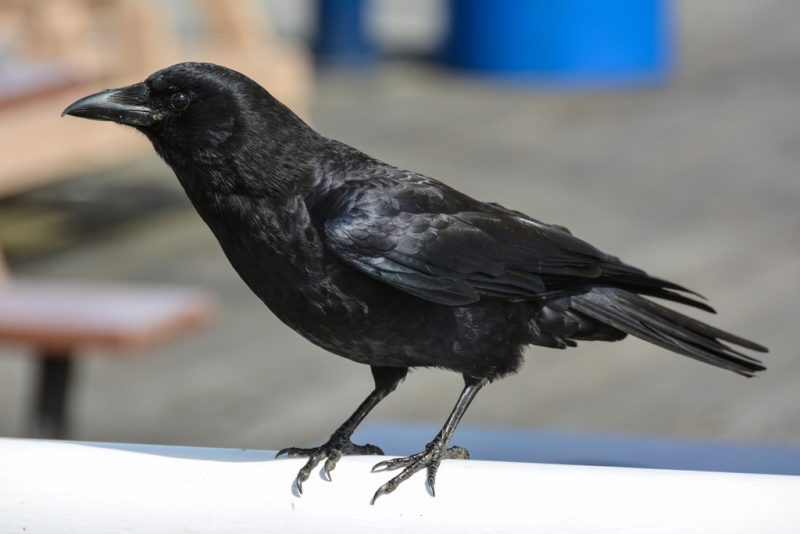
The American Crow is a large, all-black bird with glossy feathers, a sturdy bill, and strong legs. Its loud, cawing voice is unmistakable, and it is known for its intelligence and adaptability. Males and females look alike, and their powerful flight often features steady wingbeats and occasional glides.
In Arkansas, American Crows are found in nearly every habitat—forests, farmlands, suburbs, and cities. They are omnivorous, feeding on everything from insects and seeds to carrion and human scraps. They often gather in large communal roosts, especially during the winter months.
A fun fact about the American Crow is that they are capable of using tools, recognizing human faces, and even holding “funerals” where groups gather around their dead—behaviors that show their complex social intelligence.
Fish Crow (Corvus ossifragus)
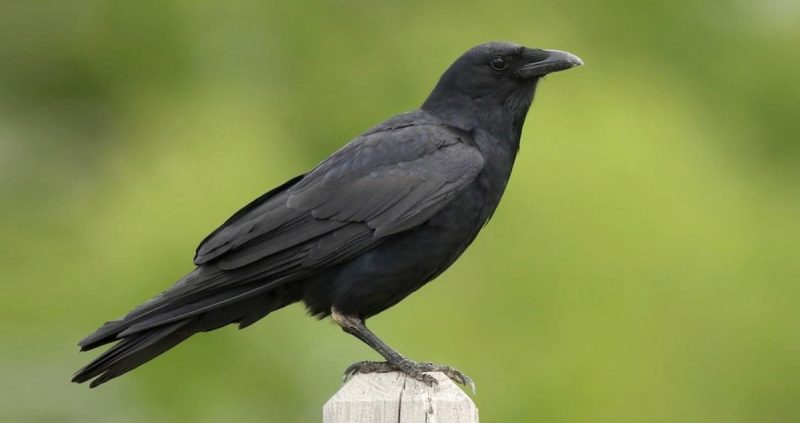
The Fish Crow closely resembles the American Crow but is slightly smaller with a more slender bill. Its plumage is equally glossy black, but its call is the best way to tell them apart—a short, nasal “uh-uh” instead of the American Crow’s sharp “caw.”
In Arkansas, Fish Crows are typically found near rivers, lakes, wetlands, and coastal areas, where they feed on fish, aquatic invertebrates, carrion, and various plant materials. They are just as adaptable as American Crows and can be seen in mixed flocks with them.
A fun fact about the Fish Crow is that it often uses its feet to hold food while eating—a behavior more commonly associated with parrots—showing its dexterity and problem-solving skills.
Mourning Dove (Zenaida macroura)
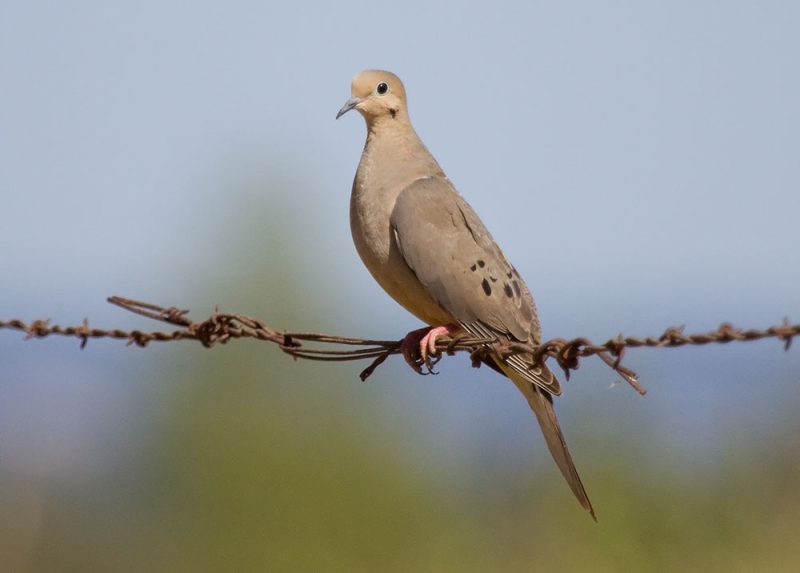
The Mourning Dove is a slender, graceful bird with soft brown and gray plumage, a small head, and a long, pointed tail edged in white. Its black spots on the wings and a gentle, cooing call make it easily recognizable.
In Arkansas, Mourning Doves are widespread in open fields, farmlands, and suburban areas. They feed mainly on seeds, often foraging on the ground, and are frequent visitors to backyard feeders. Their swift, direct flight is marked by a whistling sound from their wings.
A fun fact about Mourning Doves is that they can consume and store seeds quickly in their crop, allowing them to eat large amounts in one sitting and then digest them safely in a sheltered location away from predators.
Rock Pigeon (Columba livia)
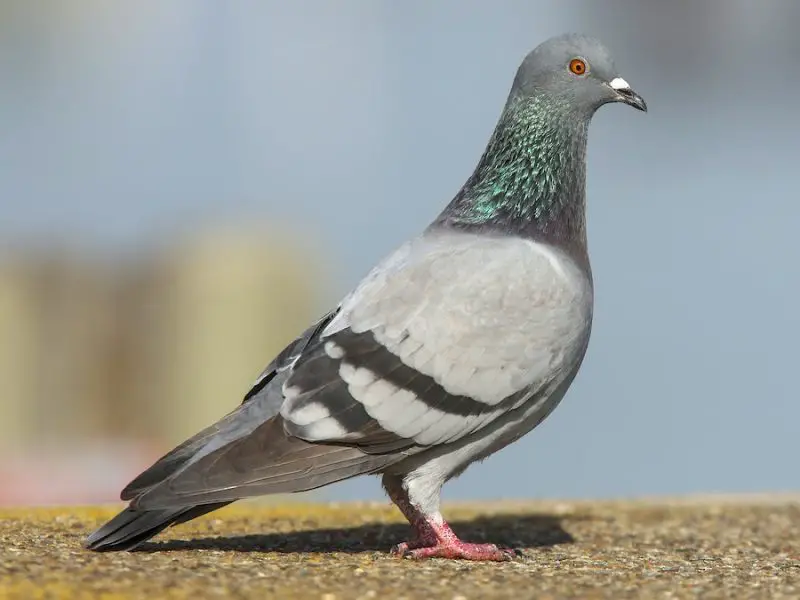
The Rock Pigeon is a stout bird with a variety of color patterns, though the most common form has gray plumage, two dark wing bars, and an iridescent neck. Domesticated for thousands of years, feral populations are now found worldwide, including in Arkansas cities and towns.
They thrive in urban environments, feeding on grains, seeds, and food scraps. Rock Pigeons nest on building ledges, bridges, and other structures that mimic the cliffs of their wild ancestors. They are social birds, often gathering in large flocks.
A fun fact about Rock Pigeons is that they have exceptional homing abilities and were once used extensively as message carriers during wars—earning them a place in history as “war heroes” among birds.
Ruby-throated Hummingbird (Archilochus colubris)
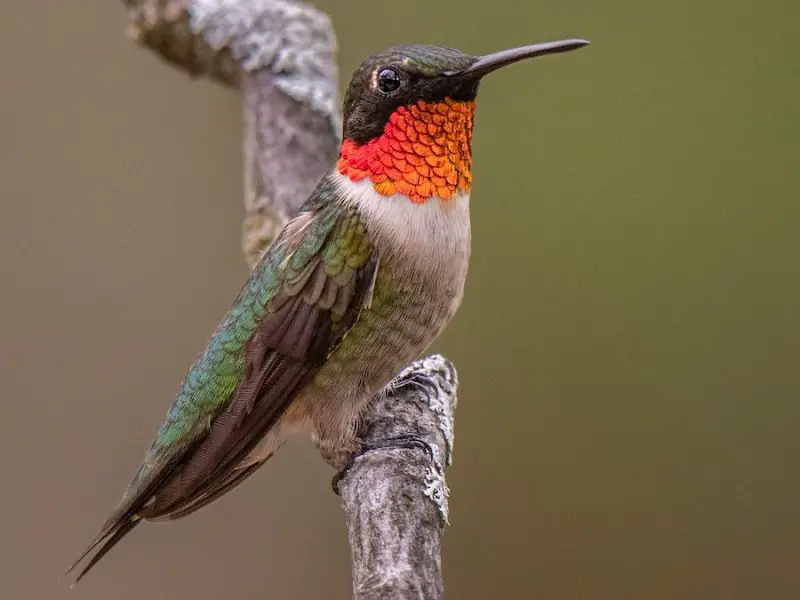
The Ruby-throated Hummingbird is a tiny, iridescent jewel of a bird. Males have a brilliant red throat that can appear black in certain light, along with emerald-green upperparts and a white belly. Females lack the red throat but share the same green and white coloration.
In Arkansas, they are common in spring and summer, visiting gardens, meadows, and forest edges. They feed on flower nectar, small insects, and spiders, often hovering in place with rapid wingbeats that can exceed 50 beats per second. These hummingbirds migrate long distances, with some flying nonstop across the Gulf of Mexico.
A fun fact about the Ruby-throated Hummingbird is that despite their tiny size, they are fiercely territorial, often chasing away much larger birds from their favorite feeding spots.
Belted Kingfisher (Megaceryle alcyon)

The Belted Kingfisher is a stocky, blue-gray bird with a large head, shaggy crest, and thick, pointed bill. Both sexes have a white collar and underparts, but females are unique among North American birds in having an extra rusty-colored band across the belly.
In Arkansas, Belted Kingfishers are often spotted near rivers, lakes, ponds, and streams, perching on branches or wires before plunging headfirst into the water to catch fish. They also eat crayfish, insects, and amphibians. Their loud, rattling calls often give them away before they are seen.
A fun fact about Belted Kingfishers is that they nest in burrows dug into sandy banks—sometimes up to 8 feet long—where they lay their eggs in darkness far from predators.
American Kestrel (Falco sparverius)
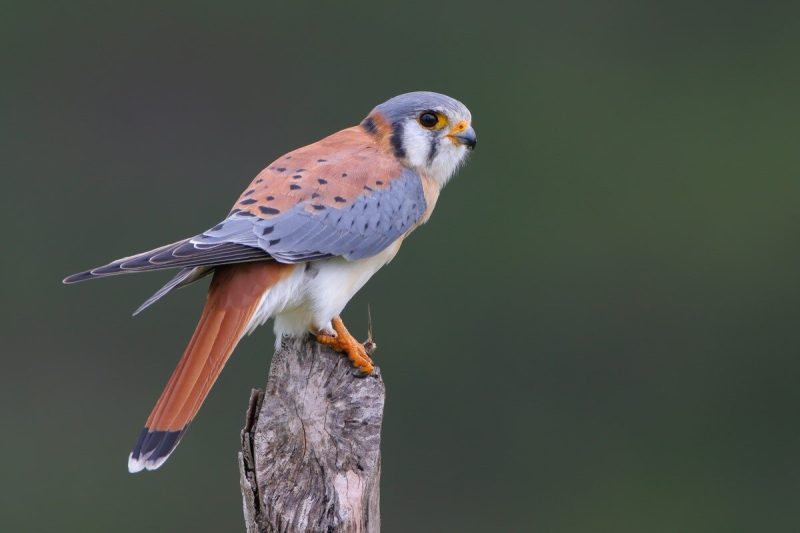
The American Kestrel is North America’s smallest falcon, with striking plumage that includes rusty-red back and tail, bluish-gray wings in males, and two bold black facial stripes. Despite its size, it is a skilled and fierce predator.
In Arkansas, kestrels inhabit open fields, pastures, and roadside perches. They hover in midair while hunting, scanning for grasshoppers, mice, and small birds. They often use old woodpecker holes or nest boxes for breeding.
A fun fact about the American Kestrel is that it can see ultraviolet light, which allows it to detect the urine trails of small mammals—a useful trick when hunting in tall grass.
Cooper’s Hawk (Accipiter cooperii)
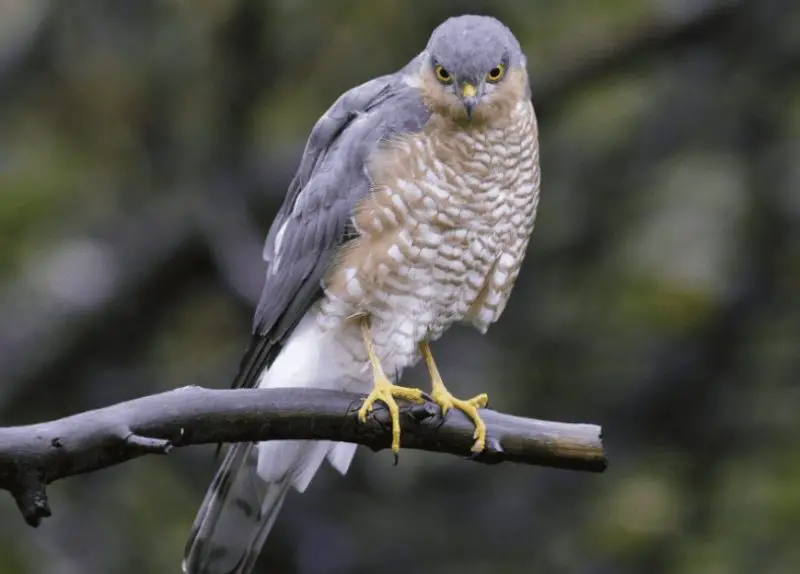
The Cooper’s Hawk is a medium-sized raptor with a long tail, rounded at the tip, and short, rounded wings. Adults have steely blue-gray upperparts, reddish barring on the chest, and piercing red eyes, while juveniles are brown with streaked underparts.
In Arkansas, Cooper’s Hawks are common in forests, woodlots, and suburban neighborhoods, where they often surprise backyard bird feeders by swooping in to catch unsuspecting songbirds. They are agile fliers, capable of weaving through dense branches in pursuit of prey.
A fun fact about Cooper’s Hawks is that they were once thought to avoid urban areas, but many now thrive in cities—taking advantage of the easy meals provided by backyard feeders.
Red-tailed Hawk (Buteo jamaicensis)

The Red-tailed Hawk is one of the most common and recognizable raptors in North America. It has broad wings, a pale belly, and a warm reddish tail in adults. Plumage varies widely, but most have a dark belly band across the chest.
In Arkansas, they can be found in open fields, woodlands, and along highways, often perched on poles or soaring overhead with slow, steady wingbeats. Their diet includes rodents, rabbits, birds, and snakes. Their piercing, descending scream is a classic sound of the countryside.
A fun fact about the Red-tailed Hawk is that its call is so iconic that Hollywood often uses it in movies for any bird of prey—even for species like eagles that sound completely different in real life.
Barred Owl (Strix varia)
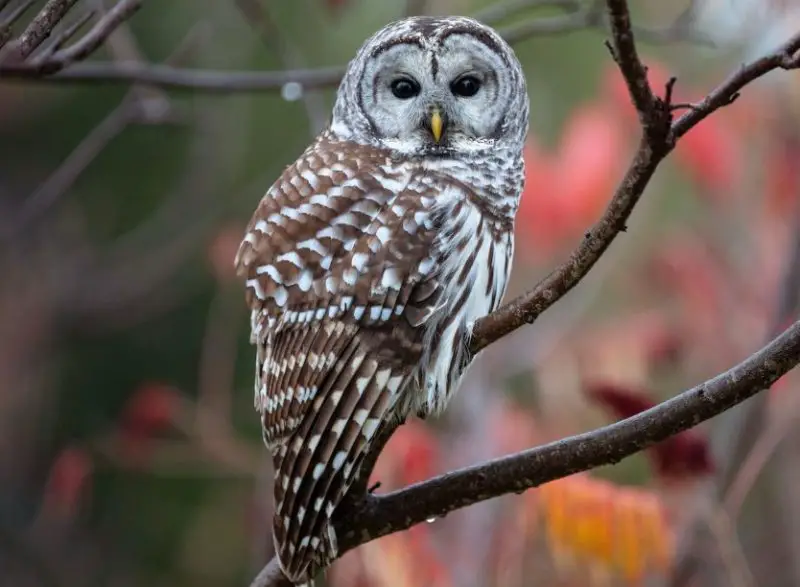
The Barred Owl is a large, round-headed owl with big dark eyes and brown-and-white striped plumage. Its name comes from the horizontal “bars” across its chest and vertical streaks on its belly.
In Arkansas, Barred Owls are found in mature forests, especially near water. They hunt mainly at night, feeding on small mammals, birds, amphibians, and reptiles. Their rich, booming call sounds like “Who cooks for you? Who cooks for you-all?” and carries far through the woods.
A fun fact about the Barred Owl is that it is less shy than many other owls and may even respond to human imitations of its call—sometimes flying in silently to investigate.
Great Horned Owl (Bubo virginianus)
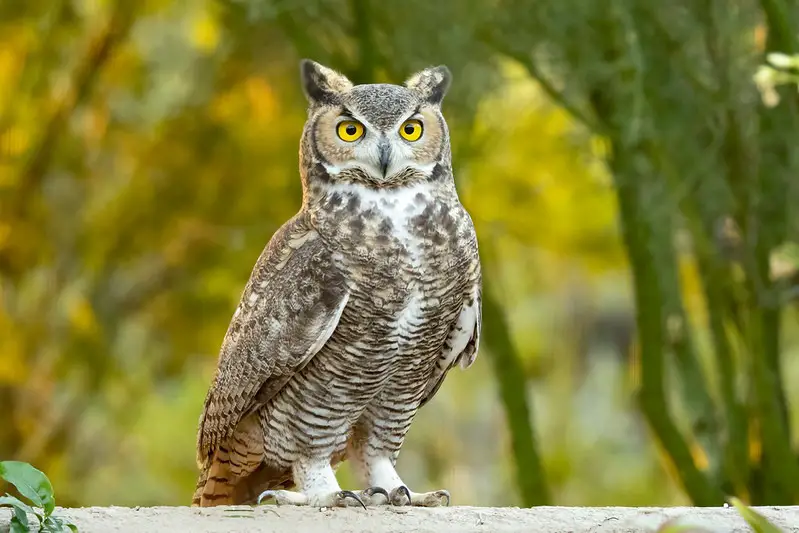
The Great Horned Owl is a powerful, large owl with prominent ear tufts (which are actually feathers), striking yellow eyes, and mottled brown plumage. Its broad wings and deep hoots make it one of the most iconic owls in North America.
In Arkansas, Great Horned Owls inhabit forests, open woodlands, farmlands, and even city parks. They are apex nocturnal predators, feeding on a wide range of prey from rabbits and squirrels to skunks and other birds, including other raptors.
A fun fact about the Great Horned Owl is that it has one of the most powerful grips of any bird—strong enough to crush the spine of its prey instantly.
Barn Owl (Tyto alba)
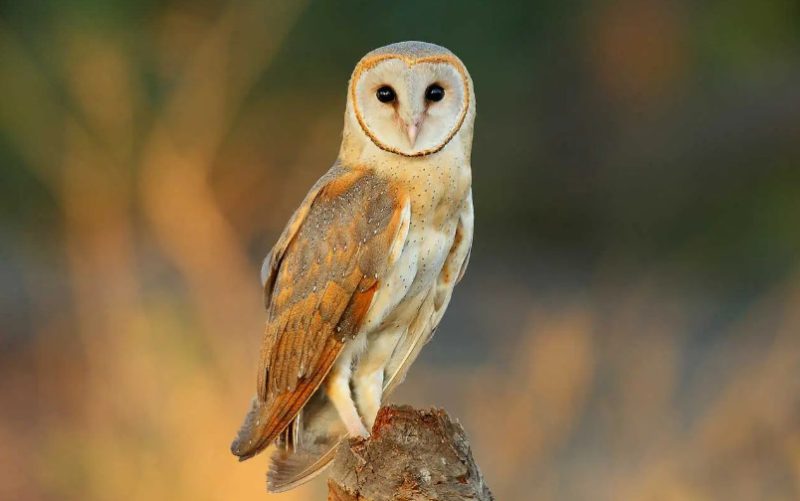
The Barn Owl is a medium-sized owl with a distinctive heart-shaped face, white underparts, and golden-buff upperparts speckled with gray. Its dark eyes and silent flight give it an almost ghostly appearance.
In Arkansas, Barn Owls are often found in open farmlands, grasslands, and marshes, nesting in barns, silos, and tree cavities. They specialize in hunting small rodents, using their exceptional hearing to locate prey in total darkness.
A fun fact about the Barn Owl is that its hearing is so sensitive it can detect the sound of a mouse moving under thick vegetation or even snow.
Great Egret (Ardea alba)

The Great Egret is a tall, elegant wading bird with all-white plumage, a long, slender neck, and a sharp yellow bill. In breeding season, it grows long, delicate plumes on its back, which were once prized in the hat trade.
In Arkansas, Great Egrets are found around wetlands, lakes, rivers, and marshes. They hunt by wading slowly or standing still, then striking quickly to catch fish, frogs, and aquatic insects. Their graceful flight shows long legs trailing behind.
A fun fact about the Great Egret is that it was the symbol that inspired the founding of the National Audubon Society, after its plumes were nearly hunted to extinction in the late 1800s.
Little Blue Heron (Egretta caerulea)
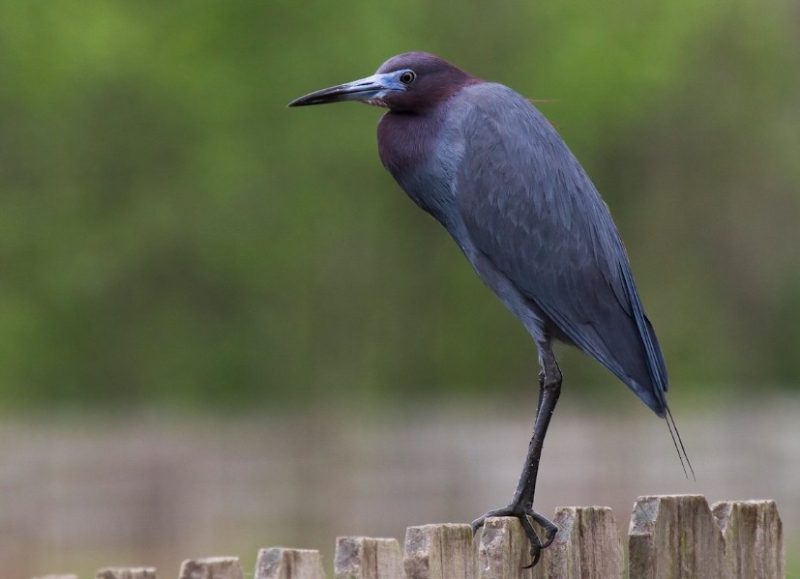
The Little Blue Heron is a medium-sized heron with slate-blue plumage as an adult, and completely white plumage as a juvenile. It has a slender neck, a dark-tipped gray bill, and greenish legs.
In Arkansas, Little Blue Herons inhabit freshwater and coastal wetlands, feeding on small fish, amphibians, and invertebrates. They are patient hunters, often standing motionless for long periods before striking.
A fun fact about the Little Blue Heron is that its white juvenile plumage may help it blend in with Snowy Egrets, allowing it to feed alongside them and take advantage of their more aggressive hunting style.
Canada Goose (Branta canadensis)
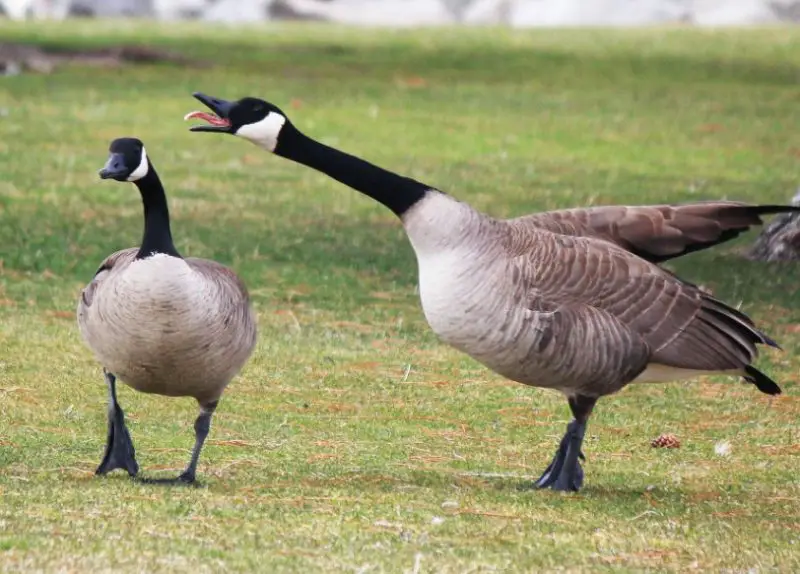
The Canada Goose is a large, long-necked waterfowl with a black head and neck, white cheek patches, and a brownish-gray body. Its distinctive honking calls are a familiar sound during migration.
In Arkansas, Canada Geese are found on lakes, rivers, wetlands, golf courses, and agricultural fields. They feed on grasses, grains, and aquatic plants. Some populations migrate seasonally, while others remain year-round residents.
A fun fact about the Canada Goose is that they are highly loyal to their mates, often pairing for life, and both parents help raise the young—a rare trait among waterfowl.
Mallard (Anas platyrhynchos)
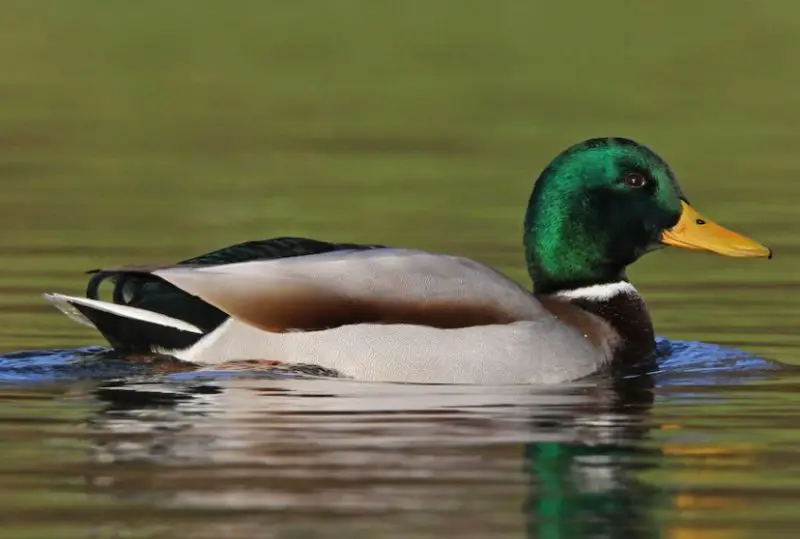
The Mallard is a large, familiar duck with a distinctive look. Males have glossy green heads, white neck rings, chestnut-brown breasts, and gray bodies, while females are mottled brown with orange bills marked in black. Both sexes have a blue wing patch bordered in white.
In Arkansas, Mallards are common on lakes, ponds, marshes, and rivers, especially during migration and winter. They feed by dabbling at the surface or tipping forward to reach underwater plants, insects, and small aquatic animals.
A fun fact about Mallards is that nearly all domestic ducks (except Muscovies) are descendants of this species, making them one of the most influential wild birds in human agriculture.
Wood Duck (Aix sponsa)
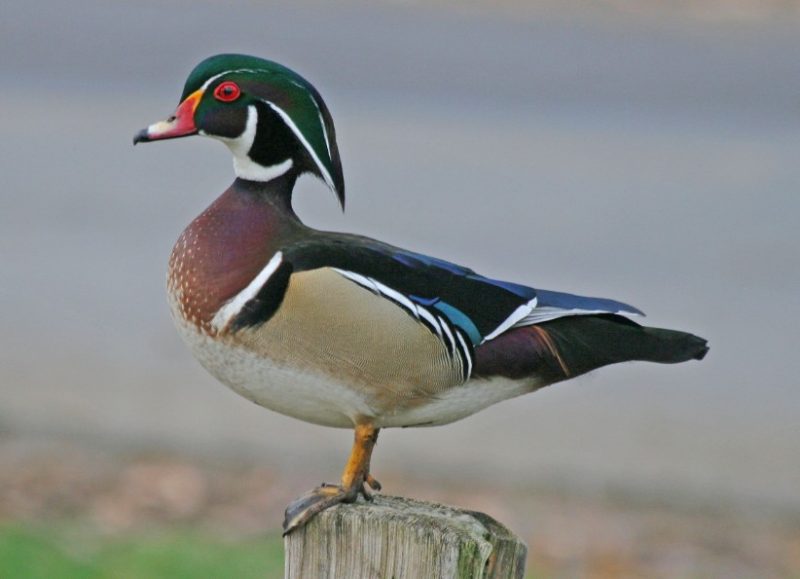
The Wood Duck is one of the most colorful waterfowl in North America. Males have iridescent green and purple heads, red eyes, and bold white markings, while females are brownish-gray with a distinctive teardrop-shaped white eye ring.
In Arkansas, Wood Ducks inhabit wooded swamps, marshes, and forested rivers. They nest in tree cavities or nest boxes and often perch on branches over water. They feed on seeds, fruits, aquatic plants, and insects.
A fun fact about the Wood Duck is that ducklings can leap from their nest cavity—sometimes over 50 feet high—just one day after hatching, bouncing on the ground or splashing into water below.
Eastern Phoebe (Sayornis phoebe)
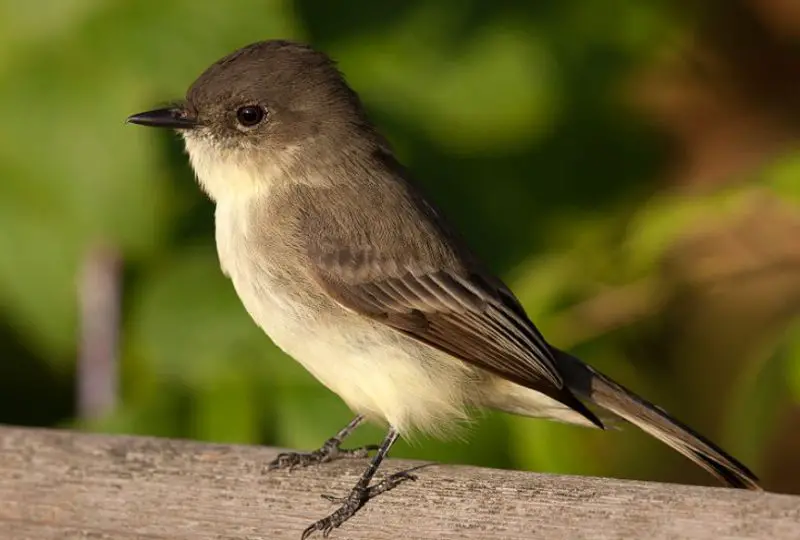
The Eastern Phoebe is a small, plain flycatcher with gray-brown upperparts, a pale belly, and a faint yellowish wash in fall. It often pumps its tail while perched, a behavior that helps distinguish it from similar species.
In Arkansas, Eastern Phoebes are found near streams, wood edges, and open areas with scattered trees. They feed mainly on flying insects, darting out from perches to snatch their prey mid-air. They often build nests on human structures like bridges, barns, and porches.
A fun fact about the Eastern Phoebe is that it was the first bird species banded in North America, by John James Audubon in 1804, in an effort to study bird migration.
Northern Mockingbird (Mimus polyglottos)
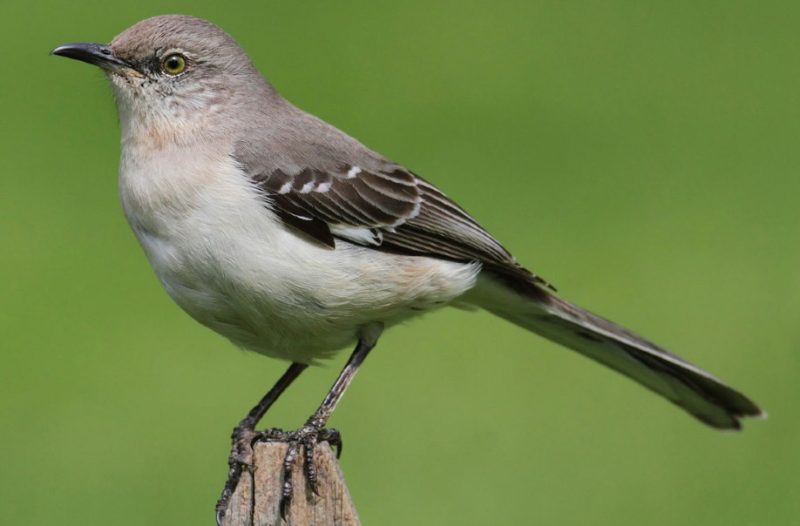
The Northern Mockingbird is a medium-sized songbird with gray upperparts, pale underparts, and white wing patches that flash in flight. Its long tail and slender build give it a graceful appearance.
In Arkansas, Northern Mockingbirds thrive in suburban areas, open fields, and forest edges. They are famous for their ability to mimic the songs of other birds, as well as sounds like car alarms or barking dogs. They feed on insects and berries.
A fun fact about the Northern Mockingbird is that an individual can learn and remember up to 200 different songs during its lifetime, constantly adding new ones to its repertoire.
Cedar Waxwing (Bombycilla cedrorum)
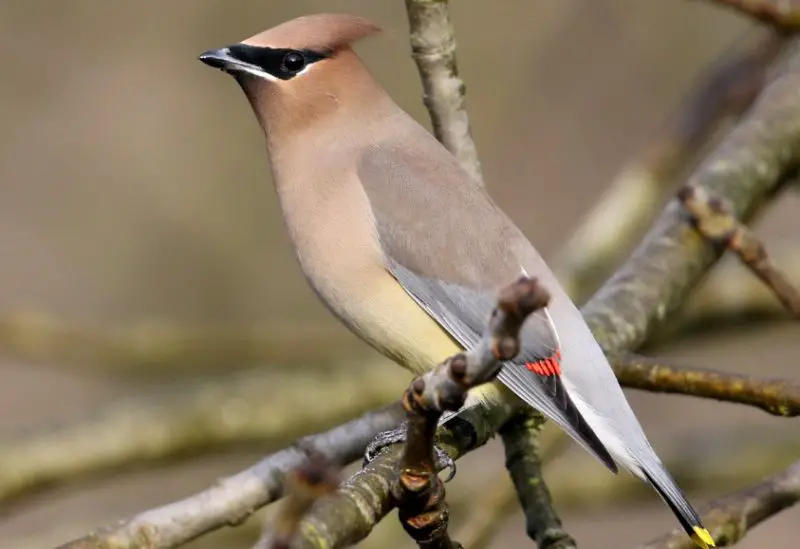
The Cedar Waxwing is a sleek, elegant bird with silky brown plumage, a pale yellow belly, a crest, and a black mask edged in white. Its name comes from the bright red, waxy tips on some of its wing feathers.
In Arkansas, Cedar Waxwings are found in flocks around fruiting trees, orchards, and woodlands, especially in winter. They feed heavily on berries but also eat insects during the breeding season.
A fun fact about Cedar Waxwings is that they sometimes pass berries from bird to bird down a line before one finally swallows it—perhaps a quirky social bonding behavior.
FAQs about Common Birds in Arkansas
What are the most common backyard birds in Arkansas?
Backyards across Arkansas often host Northern Cardinals, American Robins, Blue Jays, Tufted Titmice, and Carolina Wrens. These birds are drawn to feeders, native shrubs, and other vegetation that provides both food and shelter, making them frequent visitors to residential areas.
Which birds migrate through Arkansas?
During spring and fall, Arkansas becomes a stopover for many migratory birds. Species such as Ruby-throated Hummingbirds, Dark-eyed Juncos, White-throated Sparrows, and various warblers pass through the state, often following the Mississippi Flyway to travel between breeding and wintering grounds.
What birds are year-round residents in Arkansas?
Some species, including Northern Cardinals, Blue Jays, Tufted Titmice, Carolina Chickadees, and American Crows, remain in Arkansas throughout the year. These birds are well-adapted to seasonal changes, relying on local food sources and natural or artificial shelter.
Which birds are common in Arkansas wetlands?
Wetlands attract birds like Great Egrets, Little Blue Herons, Canada Geese, Mallards, and Wood Ducks. These birds feed in shallow waters on fish, amphibians, and aquatic plants, making wetlands a crucial habitat in the state.
What is the best way to attract birds to a backyard in Arkansas?
Providing a variety of feeders with sunflower seeds, nyjer seeds, or suet along with fresh water encourages birds to visit. Planting native shrubs and fruiting trees can offer natural food and safe nesting sites, helping to attract a wider range of species.
Are there any rare or unusual birds to watch for in Arkansas?
Occasionally, birdwatchers may spot rarer visitors such as Purple Finches, Pileated Woodpeckers, or migratory warblers. These birds are most likely to appear during winter or migration periods, offering exciting opportunities for observation.
Which birds are known for unique behaviors in Arkansas?
Some Arkansas birds exhibit fascinating behaviors. Tufted Titmice collect hair for their nests, Brown-headed Cowbirds lay eggs in other birds’ nests, Cedar Waxwings pass berries to one another before eating, and both American Crows and Fish Crows demonstrate tool use and problem-solving skills.
How can I identify birds by their calls in Arkansas?
Bird calls are helpful for identification. Northern Mockingbirds mimic other birds and sounds, Red-winged Blackbirds have a distinct “conk-la-ree” call, Mourning Doves produce a soft, mournful coo, and Barred Owls announce their presence with the “Who cooks for you-all?” call.
Do Arkansas birds use feeders or prefer natural food?
Many birds, such as House Finches, American Goldfinches, and Chickadees, readily visit feeders, while others, like Eastern Towhees and Song Sparrows, prefer foraging in leaf litter. Combining feeders with native plantings supports a diverse bird population.
When is the best time to watch birds in Arkansas?
Early mornings in spring and summer are ideal for observing active songbirds, while migration seasons in spring and fall provide chances to see both resident and transient species. Winter is also rewarding, offering opportunities to spot Dark-eyed Juncos, Purple Finches, and various waterfowl.

